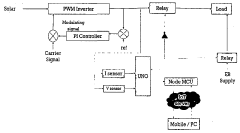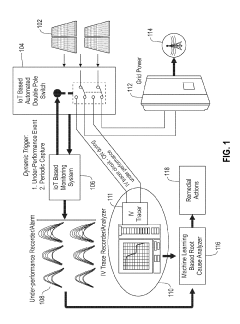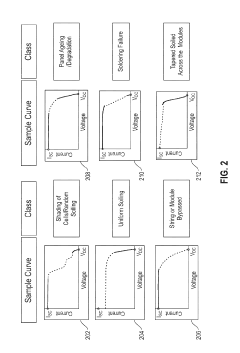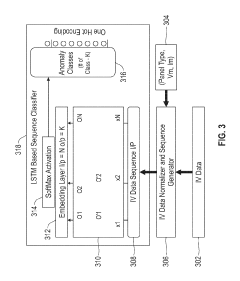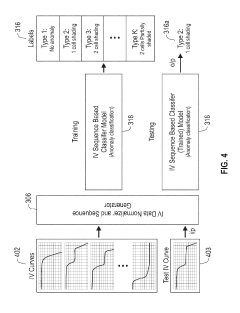Expanding Solar Inverter Capabilities Through IoT
JUL 17, 20259 MIN READ
Generate Your Research Report Instantly with AI Agent
Patsnap Eureka helps you evaluate technical feasibility & market potential.
IoT Solar Inverter Evolution and Objectives
The evolution of solar inverter technology has been closely intertwined with the rapid advancement of Internet of Things (IoT) capabilities. Over the past decade, solar inverters have transformed from simple power conversion devices to sophisticated, connected systems that play a crucial role in optimizing solar energy production and grid integration.
The initial development of solar inverters focused primarily on efficiently converting DC power from solar panels to AC power for use in homes and businesses. As the solar industry matured, the need for more intelligent and responsive inverter systems became apparent. This led to the integration of basic monitoring and communication features, allowing for remote diagnostics and simple performance tracking.
The advent of IoT technologies marked a significant turning point in solar inverter evolution. With the proliferation of low-cost, high-performance sensors and communication modules, inverters began to incorporate more advanced data collection and analysis capabilities. This shift enabled real-time monitoring of system performance, environmental conditions, and grid status, paving the way for more efficient energy management and predictive maintenance.
As IoT capabilities expanded, solar inverters evolved to become central hubs for smart energy systems. They now serve as intelligent gateways, coordinating with other smart home devices, energy storage systems, and grid operators to optimize energy flow and consumption. This integration has been crucial in addressing challenges such as grid stability, demand response, and the integration of distributed energy resources.
The current objectives for IoT-enabled solar inverters are multifaceted and ambitious. One primary goal is to enhance grid resilience and flexibility through advanced grid support functions. This includes features such as reactive power control, voltage regulation, and frequency response, which allow inverters to actively contribute to grid stability.
Another key objective is to improve overall system efficiency and reliability. By leveraging machine learning and AI algorithms, IoT-enabled inverters aim to optimize power production under varying environmental conditions, predict and prevent potential failures, and extend the lifespan of solar installations.
Furthermore, there is a growing focus on enhancing cybersecurity measures to protect these increasingly connected systems from potential threats. As solar inverters become more integral to the power infrastructure, ensuring their security and resilience against cyber attacks has become a critical objective.
Looking ahead, the evolution of IoT solar inverters is expected to continue, with objectives centered on further integration with emerging technologies such as blockchain for peer-to-peer energy trading, advanced energy storage systems, and smart grid infrastructure. The ultimate goal is to create a more sustainable, efficient, and resilient energy ecosystem that maximizes the potential of solar power generation.
The initial development of solar inverters focused primarily on efficiently converting DC power from solar panels to AC power for use in homes and businesses. As the solar industry matured, the need for more intelligent and responsive inverter systems became apparent. This led to the integration of basic monitoring and communication features, allowing for remote diagnostics and simple performance tracking.
The advent of IoT technologies marked a significant turning point in solar inverter evolution. With the proliferation of low-cost, high-performance sensors and communication modules, inverters began to incorporate more advanced data collection and analysis capabilities. This shift enabled real-time monitoring of system performance, environmental conditions, and grid status, paving the way for more efficient energy management and predictive maintenance.
As IoT capabilities expanded, solar inverters evolved to become central hubs for smart energy systems. They now serve as intelligent gateways, coordinating with other smart home devices, energy storage systems, and grid operators to optimize energy flow and consumption. This integration has been crucial in addressing challenges such as grid stability, demand response, and the integration of distributed energy resources.
The current objectives for IoT-enabled solar inverters are multifaceted and ambitious. One primary goal is to enhance grid resilience and flexibility through advanced grid support functions. This includes features such as reactive power control, voltage regulation, and frequency response, which allow inverters to actively contribute to grid stability.
Another key objective is to improve overall system efficiency and reliability. By leveraging machine learning and AI algorithms, IoT-enabled inverters aim to optimize power production under varying environmental conditions, predict and prevent potential failures, and extend the lifespan of solar installations.
Furthermore, there is a growing focus on enhancing cybersecurity measures to protect these increasingly connected systems from potential threats. As solar inverters become more integral to the power infrastructure, ensuring their security and resilience against cyber attacks has become a critical objective.
Looking ahead, the evolution of IoT solar inverters is expected to continue, with objectives centered on further integration with emerging technologies such as blockchain for peer-to-peer energy trading, advanced energy storage systems, and smart grid infrastructure. The ultimate goal is to create a more sustainable, efficient, and resilient energy ecosystem that maximizes the potential of solar power generation.
Smart Grid Integration Market Analysis
The integration of solar inverters with IoT capabilities into smart grids represents a significant market opportunity, driven by the increasing demand for renewable energy and the need for more efficient and resilient power distribution systems. The smart grid market is experiencing robust growth, with a particular focus on the integration of distributed energy resources (DERs) such as solar photovoltaic systems.
The global smart grid market is projected to expand substantially over the next decade, with solar inverter integration playing a crucial role in this growth. Key factors driving this market include government initiatives to modernize power infrastructure, the rising adoption of renewable energy sources, and the need for improved grid reliability and efficiency.
In the context of solar inverter IoT integration, the market is seeing increased demand for advanced monitoring and control capabilities. This includes real-time data analytics, predictive maintenance, and remote management features that enable utilities and energy providers to optimize grid performance and respond quickly to changing conditions.
The residential sector is emerging as a significant market segment for smart grid-integrated solar inverters. Homeowners are increasingly interested in energy management solutions that allow them to monitor and control their energy consumption and production. This trend is supported by the growing popularity of home automation systems and the desire for greater energy independence.
Commercial and industrial sectors also present substantial opportunities for smart grid-integrated solar inverters. Large-scale solar installations in these sectors require sophisticated monitoring and control systems to ensure optimal performance and seamless integration with existing power infrastructure.
Geographically, North America and Europe are leading the smart grid integration market, driven by supportive regulatory frameworks and substantial investments in grid modernization. However, the Asia-Pacific region is expected to witness the fastest growth, fueled by rapid urbanization, increasing energy demand, and government initiatives to expand renewable energy capacity.
Key market players in this space include traditional inverter manufacturers who are expanding their product offerings to include IoT capabilities, as well as technology companies specializing in smart grid solutions. Partnerships between these entities are becoming increasingly common, as they seek to leverage their respective strengths in hardware and software development.
The market for smart grid-integrated solar inverters faces some challenges, including concerns about cybersecurity and data privacy, as well as the need for standardization to ensure interoperability between different systems and devices. However, ongoing technological advancements and supportive policies are expected to address these issues and drive continued market growth in the coming years.
The global smart grid market is projected to expand substantially over the next decade, with solar inverter integration playing a crucial role in this growth. Key factors driving this market include government initiatives to modernize power infrastructure, the rising adoption of renewable energy sources, and the need for improved grid reliability and efficiency.
In the context of solar inverter IoT integration, the market is seeing increased demand for advanced monitoring and control capabilities. This includes real-time data analytics, predictive maintenance, and remote management features that enable utilities and energy providers to optimize grid performance and respond quickly to changing conditions.
The residential sector is emerging as a significant market segment for smart grid-integrated solar inverters. Homeowners are increasingly interested in energy management solutions that allow them to monitor and control their energy consumption and production. This trend is supported by the growing popularity of home automation systems and the desire for greater energy independence.
Commercial and industrial sectors also present substantial opportunities for smart grid-integrated solar inverters. Large-scale solar installations in these sectors require sophisticated monitoring and control systems to ensure optimal performance and seamless integration with existing power infrastructure.
Geographically, North America and Europe are leading the smart grid integration market, driven by supportive regulatory frameworks and substantial investments in grid modernization. However, the Asia-Pacific region is expected to witness the fastest growth, fueled by rapid urbanization, increasing energy demand, and government initiatives to expand renewable energy capacity.
Key market players in this space include traditional inverter manufacturers who are expanding their product offerings to include IoT capabilities, as well as technology companies specializing in smart grid solutions. Partnerships between these entities are becoming increasingly common, as they seek to leverage their respective strengths in hardware and software development.
The market for smart grid-integrated solar inverters faces some challenges, including concerns about cybersecurity and data privacy, as well as the need for standardization to ensure interoperability between different systems and devices. However, ongoing technological advancements and supportive policies are expected to address these issues and drive continued market growth in the coming years.
Current IoT Solar Inverter Challenges
The integration of IoT technology into solar inverters has brought significant advancements in the renewable energy sector. However, several challenges persist in the current landscape of IoT-enabled solar inverters. One of the primary issues is the lack of standardization across different manufacturers and models, leading to compatibility problems and difficulties in system integration.
Security concerns remain a critical challenge for IoT solar inverters. As these devices are connected to the internet, they become potential targets for cyberattacks. Vulnerabilities in the firmware or communication protocols could lead to unauthorized access, data breaches, or even manipulation of the inverter's operations, potentially compromising the entire solar power system.
Data management and analytics pose another significant challenge. IoT solar inverters generate vast amounts of data, including power output, efficiency metrics, and system health information. Processing, storing, and analyzing this data in real-time to derive actionable insights requires robust infrastructure and advanced analytics capabilities, which many current systems lack.
Connectivity issues also hinder the full potential of IoT solar inverters. Reliable and consistent internet connectivity is crucial for real-time monitoring and control. However, solar installations in remote or rural areas often face connectivity problems, leading to gaps in data collection and reduced system performance.
The complexity of IoT solar inverter systems presents challenges in terms of installation, maintenance, and troubleshooting. Many technicians and installers lack the necessary skills to effectively manage these advanced systems, leading to suboptimal performance and increased downtime.
Scalability is another hurdle for IoT solar inverters. As solar installations grow in size and complexity, the IoT infrastructure must be able to handle increased data loads and device connections without compromising performance or reliability. Current systems often struggle to scale efficiently, limiting their applicability in large-scale solar projects.
Energy storage integration remains a challenge for IoT solar inverters. While many modern inverters can interface with battery systems, optimizing the interplay between solar generation, energy storage, and grid interaction in real-time is a complex task that current systems are still perfecting.
Lastly, the cost of implementing and maintaining IoT capabilities in solar inverters is a significant barrier, especially for smaller-scale installations. The additional hardware, software, and ongoing service costs associated with IoT features can impact the overall return on investment for solar projects, deterring widespread adoption.
Addressing these challenges is crucial for expanding the capabilities of solar inverters through IoT technology and realizing the full potential of smart, connected solar energy systems.
Security concerns remain a critical challenge for IoT solar inverters. As these devices are connected to the internet, they become potential targets for cyberattacks. Vulnerabilities in the firmware or communication protocols could lead to unauthorized access, data breaches, or even manipulation of the inverter's operations, potentially compromising the entire solar power system.
Data management and analytics pose another significant challenge. IoT solar inverters generate vast amounts of data, including power output, efficiency metrics, and system health information. Processing, storing, and analyzing this data in real-time to derive actionable insights requires robust infrastructure and advanced analytics capabilities, which many current systems lack.
Connectivity issues also hinder the full potential of IoT solar inverters. Reliable and consistent internet connectivity is crucial for real-time monitoring and control. However, solar installations in remote or rural areas often face connectivity problems, leading to gaps in data collection and reduced system performance.
The complexity of IoT solar inverter systems presents challenges in terms of installation, maintenance, and troubleshooting. Many technicians and installers lack the necessary skills to effectively manage these advanced systems, leading to suboptimal performance and increased downtime.
Scalability is another hurdle for IoT solar inverters. As solar installations grow in size and complexity, the IoT infrastructure must be able to handle increased data loads and device connections without compromising performance or reliability. Current systems often struggle to scale efficiently, limiting their applicability in large-scale solar projects.
Energy storage integration remains a challenge for IoT solar inverters. While many modern inverters can interface with battery systems, optimizing the interplay between solar generation, energy storage, and grid interaction in real-time is a complex task that current systems are still perfecting.
Lastly, the cost of implementing and maintaining IoT capabilities in solar inverters is a significant barrier, especially for smaller-scale installations. The additional hardware, software, and ongoing service costs associated with IoT features can impact the overall return on investment for solar projects, deterring widespread adoption.
Addressing these challenges is crucial for expanding the capabilities of solar inverters through IoT technology and realizing the full potential of smart, connected solar energy systems.
Existing IoT-Enabled Inverter Solutions
01 Grid integration and power management
Solar inverters are capable of integrating with the power grid, managing power flow, and providing grid support functions. They can regulate active and reactive power, perform voltage and frequency control, and enable seamless transitions between grid-connected and off-grid modes. These capabilities enhance grid stability and allow for efficient utilization of solar energy.- Grid integration and power quality improvement: Solar inverters are designed to seamlessly integrate with the power grid, providing features such as voltage and frequency regulation, reactive power control, and harmonic mitigation. These capabilities help maintain grid stability and improve overall power quality, ensuring smooth operation of the electrical system.
- Maximum power point tracking (MPPT): Solar inverters incorporate advanced MPPT algorithms to optimize energy harvest from photovoltaic panels. These algorithms continuously adjust the operating point of the solar array to extract maximum power under varying environmental conditions, such as changes in irradiance and temperature.
- Energy storage integration and management: Modern solar inverters can interface with energy storage systems, enabling features like load shifting, peak shaving, and backup power. These inverters manage the flow of energy between the solar panels, battery storage, and the grid, optimizing energy usage and increasing system flexibility.
- Smart monitoring and communication: Solar inverters are equipped with advanced monitoring and communication capabilities, allowing real-time data collection, performance analysis, and remote management. These features enable system owners and operators to optimize energy production, detect faults, and perform predictive maintenance.
- Safety and protection features: Solar inverters incorporate various safety and protection mechanisms to ensure reliable operation and prevent damage to the system or connected equipment. These features include anti-islanding protection, ground fault detection, surge protection, and automatic shutdown in case of grid instability or system faults.
02 Maximum power point tracking (MPPT)
Solar inverters employ advanced MPPT algorithms to optimize power extraction from photovoltaic panels. These algorithms continuously adjust the operating point of the solar array to maximize energy yield under varying environmental conditions, such as changes in irradiance and temperature. MPPT capabilities ensure efficient conversion of solar energy into usable electricity.Expand Specific Solutions03 Energy storage integration
Modern solar inverters can integrate with energy storage systems, such as batteries. This capability allows for storing excess solar energy during peak production periods and utilizing it during low production or high demand periods. The integration of energy storage enhances system flexibility, improves self-consumption, and provides backup power during grid outages.Expand Specific Solutions04 Smart monitoring and communication
Solar inverters are equipped with advanced monitoring and communication capabilities. They can collect and transmit real-time data on system performance, energy production, and grid conditions. These features enable remote monitoring, diagnostics, and control of solar power systems, facilitating efficient operation and maintenance.Expand Specific Solutions05 Multi-level and modular designs
Solar inverters utilize multi-level and modular designs to improve efficiency, reliability, and scalability. These designs allow for better power quality, reduced harmonic distortion, and enhanced fault tolerance. Modular architectures enable easier maintenance, upgrades, and system expansion to accommodate growing energy needs.Expand Specific Solutions
Key Solar IoT Solution Providers
The market for expanding solar inverter capabilities through IoT is in a growth phase, driven by increasing demand for smart energy solutions. The global solar inverter market is projected to reach significant size in the coming years, with IoT integration playing a crucial role. Technologically, the field is rapidly evolving, with companies like SMA Solar Technology AG and Yuneng Technology Co., Ltd. leading innovation. These firms are developing advanced IoT-enabled inverters that offer improved efficiency, remote monitoring, and grid integration capabilities. While the technology is maturing, there's still room for further advancements in areas such as predictive maintenance, energy optimization, and seamless smart home integration.
SMA Solar Technology AG
Technical Solution: SMA Solar Technology AG has developed advanced IoT-enabled solar inverters that integrate seamlessly with their SMA Smart Connected system. This solution utilizes real-time data analytics and machine learning algorithms to optimize inverter performance, predict maintenance needs, and enhance overall system efficiency. The inverters feature built-in communication modules that enable secure, bi-directional data transfer between the devices and SMA's cloud platform[1]. This allows for remote monitoring, control, and firmware updates, significantly reducing downtime and operational costs. SMA's inverters also incorporate adaptive grid management functions, enabling them to respond dynamically to grid conditions and contribute to grid stability[2].
Strengths: Industry-leading IoT integration, advanced predictive maintenance, and grid support features. Weaknesses: Potentially higher initial costs and reliance on proprietary ecosystem.
International Business Machines Corp.
Technical Solution: IBM has developed an IoT-based solar inverter management system that leverages their Watson AI platform. This solution integrates with various inverter brands, collecting data from sensors and inverters to create a comprehensive view of solar farm operations. The system uses advanced analytics to optimize inverter performance, predict equipment failures, and automate maintenance scheduling. IBM's platform also incorporates blockchain technology to enhance data security and enable transparent energy trading[3]. The solution includes edge computing capabilities, allowing for real-time decision-making at the inverter level, reducing latency and improving response times to grid fluctuations[4].
Strengths: Powerful AI and analytics capabilities, brand-agnostic integration, and blockchain-enhanced security. Weaknesses: Complexity of implementation and potential high costs for smaller operations.
Core IoT Solar Inverter Innovations
IoT based solar smart multilevel PWM inverter
PatentPendingIN202241024428A
Innovation
- The development of an IoT-based Solar Smart Multilevel PWM Inverter system, utilizing components such as power supply, solar panels, voltage and current sensors, mobile devices, personal computers, Arduino, NodeMCU, and relays to continuously monitor and control inverter output, enabling remote load management and monitoring of DC supply for smart energy distribution.
Internet of Things-Enabled Solar Photovoltaic Health Monitoring and Advising Related Thereto
PatentInactiveUS20190312547A1
Innovation
- An IoT-enabled solar PV health monitoring system that uses machine learning techniques to analyze current-voltage samples from PV modules, performing root cause analysis and automatically generating remedial actions by classifying anomalies through sequence or feature-based classification methods.
Cybersecurity in IoT Solar Inverters
As the integration of Internet of Things (IoT) technology with solar inverters continues to expand, cybersecurity has become a critical concern for manufacturers, installers, and end-users alike. The interconnected nature of IoT-enabled solar inverters introduces new vulnerabilities that malicious actors could potentially exploit, making robust cybersecurity measures essential for protecting these systems and the broader energy infrastructure they support.
One of the primary cybersecurity challenges in IoT solar inverters is the need to secure communication channels between the inverter, local networks, and cloud-based management platforms. Encryption protocols such as TLS/SSL are widely implemented to protect data in transit, but ongoing vigilance is required to ensure these protocols remain up-to-date and resistant to emerging threats. Additionally, secure authentication mechanisms, including multi-factor authentication and digital certificates, are crucial for preventing unauthorized access to inverter controls and data.
Device-level security is another key focus area for IoT solar inverters. Manufacturers are implementing secure boot processes, firmware signing, and hardware-based security modules to protect against tampering and ensure the integrity of the inverter's software. Regular firmware updates are essential for addressing newly discovered vulnerabilities, but the update process itself must be secured to prevent it from becoming an attack vector.
Network segmentation and intrusion detection systems play a vital role in protecting IoT solar inverters from broader network-based attacks. By isolating inverters on separate network segments and monitoring for suspicious activity, operators can minimize the risk of lateral movement by attackers who may have gained access to other parts of the network.
Data privacy is an increasingly important aspect of cybersecurity for IoT solar inverters, particularly as these devices collect and transmit more detailed information about energy production and consumption patterns. Compliance with data protection regulations such as GDPR and CCPA requires careful management of user data, including secure storage, controlled access, and the ability to delete or anonymize data upon request.
As the threat landscape evolves, so too must the cybersecurity strategies for IoT solar inverters. Artificial intelligence and machine learning are being leveraged to develop more sophisticated threat detection and response capabilities, enabling systems to identify and mitigate potential attacks in real-time. Furthermore, the adoption of blockchain technology is being explored as a means to enhance the security and integrity of energy transactions and data sharing between distributed energy resources.
One of the primary cybersecurity challenges in IoT solar inverters is the need to secure communication channels between the inverter, local networks, and cloud-based management platforms. Encryption protocols such as TLS/SSL are widely implemented to protect data in transit, but ongoing vigilance is required to ensure these protocols remain up-to-date and resistant to emerging threats. Additionally, secure authentication mechanisms, including multi-factor authentication and digital certificates, are crucial for preventing unauthorized access to inverter controls and data.
Device-level security is another key focus area for IoT solar inverters. Manufacturers are implementing secure boot processes, firmware signing, and hardware-based security modules to protect against tampering and ensure the integrity of the inverter's software. Regular firmware updates are essential for addressing newly discovered vulnerabilities, but the update process itself must be secured to prevent it from becoming an attack vector.
Network segmentation and intrusion detection systems play a vital role in protecting IoT solar inverters from broader network-based attacks. By isolating inverters on separate network segments and monitoring for suspicious activity, operators can minimize the risk of lateral movement by attackers who may have gained access to other parts of the network.
Data privacy is an increasingly important aspect of cybersecurity for IoT solar inverters, particularly as these devices collect and transmit more detailed information about energy production and consumption patterns. Compliance with data protection regulations such as GDPR and CCPA requires careful management of user data, including secure storage, controlled access, and the ability to delete or anonymize data upon request.
As the threat landscape evolves, so too must the cybersecurity strategies for IoT solar inverters. Artificial intelligence and machine learning are being leveraged to develop more sophisticated threat detection and response capabilities, enabling systems to identify and mitigate potential attacks in real-time. Furthermore, the adoption of blockchain technology is being explored as a means to enhance the security and integrity of energy transactions and data sharing between distributed energy resources.
Energy Policy Impact on IoT Inverters
Energy policies play a crucial role in shaping the adoption and development of IoT-enabled solar inverters. As governments worldwide increasingly focus on renewable energy and smart grid solutions, policies are being implemented to support the integration of advanced inverter technologies. These policies often include financial incentives, regulatory frameworks, and technical standards that directly impact the IoT capabilities of solar inverters.
Many countries have introduced feed-in tariffs and net metering policies to encourage solar energy adoption. These policies create a favorable environment for IoT-enabled inverters, as they require accurate monitoring and reporting of energy production and consumption. As a result, inverter manufacturers are incentivized to incorporate advanced communication and data analytics features into their products.
Grid interconnection standards are evolving to accommodate the growing number of distributed energy resources. These standards often mandate specific functionalities for inverters, such as voltage and frequency regulation, which can be more effectively managed through IoT capabilities. For instance, the IEEE 1547-2018 standard in the United States requires inverters to have advanced grid support features, driving the integration of IoT technologies for improved grid stability and reliability.
Energy storage policies are also influencing the development of IoT-enabled inverters. As governments promote the adoption of battery storage systems alongside solar installations, inverters are increasingly required to manage complex energy flows between solar panels, batteries, and the grid. This necessitates sophisticated IoT capabilities for real-time monitoring, forecasting, and optimization of energy storage and distribution.
Cybersecurity regulations are becoming more stringent in the energy sector, impacting the design and implementation of IoT features in solar inverters. Policymakers are introducing guidelines and standards to ensure the security and resilience of grid-connected devices, including inverters. This is driving manufacturers to enhance their IoT security measures and implement robust data protection protocols.
Smart meter rollouts and demand response programs, supported by various energy policies, are creating new opportunities for IoT-enabled inverters. These initiatives require inverters to communicate with other smart devices and respond to grid signals, further expanding their IoT capabilities. As a result, inverter manufacturers are developing more advanced communication protocols and integrating their products with broader energy management ecosystems.
Carbon pricing mechanisms and renewable energy certificates are indirectly influencing the IoT capabilities of solar inverters. These policies create a market for accurate energy production data and emissions reduction verification, which can be facilitated by IoT-enabled inverters. Consequently, manufacturers are incorporating features such as blockchain integration and advanced data analytics to support these market mechanisms.
Many countries have introduced feed-in tariffs and net metering policies to encourage solar energy adoption. These policies create a favorable environment for IoT-enabled inverters, as they require accurate monitoring and reporting of energy production and consumption. As a result, inverter manufacturers are incentivized to incorporate advanced communication and data analytics features into their products.
Grid interconnection standards are evolving to accommodate the growing number of distributed energy resources. These standards often mandate specific functionalities for inverters, such as voltage and frequency regulation, which can be more effectively managed through IoT capabilities. For instance, the IEEE 1547-2018 standard in the United States requires inverters to have advanced grid support features, driving the integration of IoT technologies for improved grid stability and reliability.
Energy storage policies are also influencing the development of IoT-enabled inverters. As governments promote the adoption of battery storage systems alongside solar installations, inverters are increasingly required to manage complex energy flows between solar panels, batteries, and the grid. This necessitates sophisticated IoT capabilities for real-time monitoring, forecasting, and optimization of energy storage and distribution.
Cybersecurity regulations are becoming more stringent in the energy sector, impacting the design and implementation of IoT features in solar inverters. Policymakers are introducing guidelines and standards to ensure the security and resilience of grid-connected devices, including inverters. This is driving manufacturers to enhance their IoT security measures and implement robust data protection protocols.
Smart meter rollouts and demand response programs, supported by various energy policies, are creating new opportunities for IoT-enabled inverters. These initiatives require inverters to communicate with other smart devices and respond to grid signals, further expanding their IoT capabilities. As a result, inverter manufacturers are developing more advanced communication protocols and integrating their products with broader energy management ecosystems.
Carbon pricing mechanisms and renewable energy certificates are indirectly influencing the IoT capabilities of solar inverters. These policies create a market for accurate energy production data and emissions reduction verification, which can be facilitated by IoT-enabled inverters. Consequently, manufacturers are incorporating features such as blockchain integration and advanced data analytics to support these market mechanisms.
Unlock deeper insights with Patsnap Eureka Quick Research — get a full tech report to explore trends and direct your research. Try now!
Generate Your Research Report Instantly with AI Agent
Supercharge your innovation with Patsnap Eureka AI Agent Platform!
